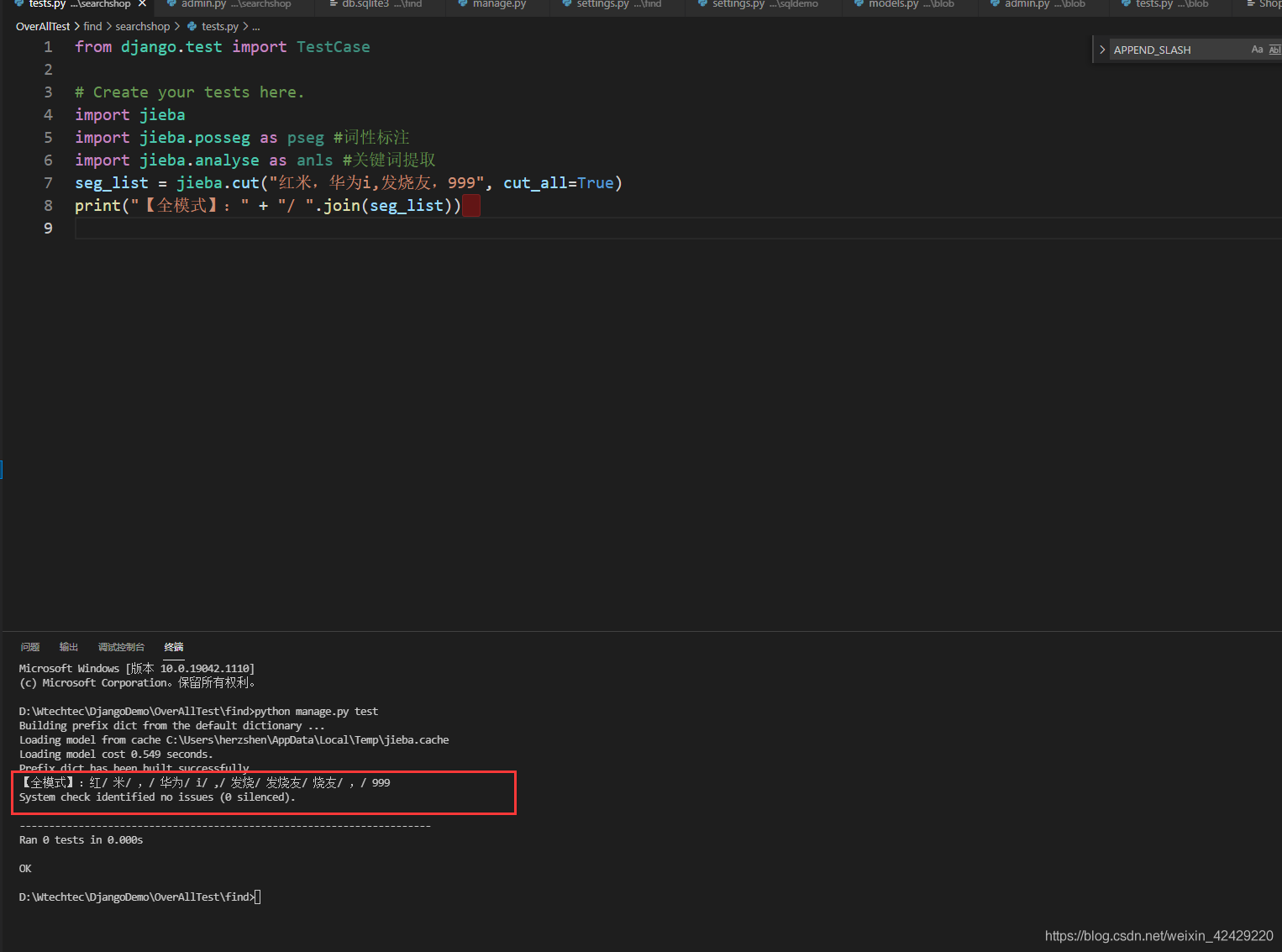这篇文章主要介绍“django怎么用分词器实现站内检索功能”,在日常操作中,相信很多人在django怎么用分词器实现站内检索功能问题上存在疑惑,小编查阅了各式资料,整理出简单好用的操作方法,希望对大家解答”django怎么用分词器实现站内检索功能”的疑惑有所帮助!接下来,请跟着小编一起来学习吧!
源码
安装库:
pip install django-haystack pip install whoosh pip install jieba
如果pip 安装超时,可配置pip国内源下载,如下:
pip install -i http://mirrors.aliyun.com/pypi/simple/ --trusted-host mirrors.aliyun.com <安装的库>pip install -i http://mirrors.aliyun.com/pypi/simple/ --trusted-host mirrors.aliyun.com django如果安装 django-haystack 失败,先安装 setuptools_scm .在安装 django-haystack.
pip install setuptools_scm
创建项目demo:
# django-admin startproject <项目名>
django-admin startproject find切入demo 终端操作,创建app:
# python manage.py startapp <APP名>
python manage.py startapp searchshop在 settings.py 文件 中的 INSTALLED_APPS 配置 注入 刚才创建APP( 路径: find/find/settings.py):
INSTALLED_APPS = [
...
'searchshop',
...
]在创建的APP中添加模型
models.py 文件添加如下(路径: find/searchshop/models.py):
class Shopp(models.Model):
shop_name = models.TextField(max_length=200)
shop_price = models.IntegerField(default=0)
shop_dsc = models.CharField(max_length=200)在app 中admin.py文件注册模型:
admin.py 文件添加如下(路径: find/searchshop/admin.py):
from .models import Shopp
admin.site.register(Shopp)执行命令,让模型生效(修改模型时,都要执行一次,这样模型才同步!!!):
python manage.py makemigrations python manage.py migrate
访问后台可操作模型数据:
python manage.py createsuperuser
运行:
python manage.py runserver
访问: http:127.0.0.1:8080/admin 登录刚才设置帐号,密码即可进入:

配置 haystack
在 settings.py 文件 中的 INSTALLED_APPS 配置最底部 注入 haystack( 路径: find/find/settings.py):
INSTALLED_APPS = [
...
'haystack'
]在app内,添加 search_indexes.py (目录:find/searchshop/search_indexes.py):
from haystack import indexes
from .models import Shopp # 之前创建的模型
# 修改此处,类名为模型类的名称+Index,比如模型类为GoodsInfo,则这里类名为GoodsInfoIndex(其实可以随便写)
class ArticlePostIndex(indexes.SearchIndex, indexes.Indexable):
# text为索引字段
# document = True,这代表haystack和搜索引擎将使用此字段的内容作为索引进行检索
# use_template=True 指定根据表中的那些字段建立索引文件的说明放在一个文件中
text = indexes.CharField(document=True, use_template=True)
# 对那张表进行查询
def get_model(self): # 重载get_model方法,必须要有!
# 返回这个model
return Shopp
# 建立索引的数据
def index_queryset(self, using=None):
# 这个方法返回什么内容,最终就会对那些方法建立索引,这里是对所有字段建立索引
return self.get_model().objects.all()生成检索索引
python manage.py rebuild_index
项目目录多出whoosh_index文件夹.
修改分词器
从 pyrhon 安装路径 ( \Lib\site-packages\haystack\backends\whoosh_backend.py) 复制一份到app中改名为 whoosh_cn_backend (find/searchshop/whoosh_cn_backend.py)
在顶部引用:
from jieba.analyse import ChineseAnalyzer找到 (查找 StemmingAnalyzer ) 位置:
schema_fields[field_class.index_fieldname] = TEXT(
stored=True,
analyzer=StemmingAnalyzer(),
field_boost=field_class.boost,
sortable=True,
)替换:
schema_fields[field_class.index_fieldname] = TEXT(stored=True, analyzer=ChineseAnalyzer(),
field_boost=field_class.boost)在 INSTALLED_APPS(路径: find/find/settings.py) 配置后面 后面添加:
HAYSTACK_CONNECTIONS = {
'default': {
# 指定whoosh引擎 (之前创建的whoosh_cn_backend)
'ENGINE': 'searchshop.whoosh_cn_backend.WhooshEngine',
# 'ENGINE': 'jsapp.whoosh_cn_backend.WhooshEngine', # whoosh_cn_backend是haystack的whoosh_backend.py改名的文件为了使用jieba分词
# 索引文件路径
'PATH': os.path.join(BASE_DIR, 'whoosh_index'),
}
}
# 添加此项,当数据库改变时,会自动更新索引,非常方便
HAYSTACK_SIGNAL_PROCESSOR = 'haystack.signals.RealtimeSignalProcessor'添加 templates
在APP中创建 templates文件夹.
添加内容检索内容
在templates文件夹下创建文件夹 search -> indexes -> searchshop( search + APP名);
路径( 目录: find/searchshop\templates\search\indexes\searchshop) 添加Shopp_text.txt(APP名_text.txt): (需要检索的字段名)
{{object.shop_name}}
{{object.shop_dsc}}
{{object.shop_price}}添加页面模板
在templates文件夹下创建文件夹(searchshop) 下创建index.html:
{% load highlight %}
<!DOCTYPE html>
<html lang="en">
<head>
<meta charset="UTF-8">
<title>商品列表</title>
<style>
span.highlighted {
color: red;
}
</style>
</head>
<body>
<div class="search">
<form method="get" action="{% url 'shop:search' %}">
<input type="text" name="q" placeholder="a搜索商品">
<input type="submit" value="搜索">
</form>
</div>
{% if shop_list and query %}
<ul>
{% for question in shop_list %}
<li>
{% highlight question.object.shop_name with query %}
价格: {% highlight question.object.shop_price with query %}
<span class="post-author"> <a> {% highlight question.object.shop_dsc with query %} </a></span>
</li>
{% endfor %}
</ul>
{% else %}
<p>No polls are available.</p>
{% endif %}
</body>
</html>load highlight : 加载高亮.
query : 检索词
shop_list : 检索结果
目录: find/searchshop/views.py
from django.shortcuts import render
from django.http import HttpResponse
#Create your views here.
from .models import Shopp
from haystack.forms import ModelSearchForm
from haystack.query import EmptySearchQuerySet
def index(request):
shop_list = Shopp.objects.all()
context = {
'query': '',
'shop_list': shop_list
}
return render(request, 'searchshop/index.html', context)
def search(request, load_all=True, form_class=ModelSearchForm, searchqueryset=None):
if request.GET.get('q'):
form = form_class(request.GET, searchqueryset=searchqueryset, load_all=load_all)
if form.is_valid():
query = form.cleaned_data['q']
results = form.search()
context = {
'query': query,
'shop_list': results
}
return render(request, 'searchshop/index.html', context)
# results = form.search()
return HttpResponse(request.GET.get('q'))
return HttpResponse('查询')在 find/searchshop 创建 urls.py
from . import views
app_name = 'shop' # 重点是这一行
urlpatterns = [
path('', views.index, name='index'),
path('search', views.search, name='search'),
# path(r'search/$', views.search, name='search')
]修改 urls.py(目录: find/find/urls.py)
from django.urls import path, include
urlpatterns = [
path('shop', include('searchshop.urls')),
path('admin/', admin.site.urls),
]运行:
python manage.py runserver
测试
http://127.0.0.1:8000/shop


所以'红米'查询不到…

到此,关于“django怎么用分词器实现站内检索功能”的学习就结束了,希望能够解决大家的疑惑。理论与实践的搭配能更好的帮助大家学习,快去试试吧!若想继续学习更多相关知识,请继续关注亿速云网站,小编会继续努力为大家带来更多实用的文章!
亿速云「云服务器」,即开即用、新一代英特尔至强铂金CPU、三副本存储NVMe SSD云盘,价格低至29元/月。点击查看>>
免责声明:本站发布的内容(图片、视频和文字)以原创、转载和分享为主,文章观点不代表本网站立场,如果涉及侵权请联系站长邮箱:is@yisu.com进行举报,并提供相关证据,一经查实,将立刻删除涉嫌侵权内容。